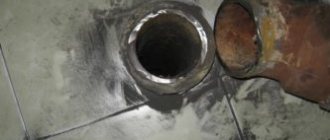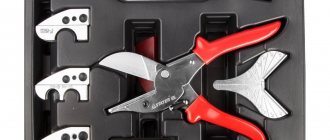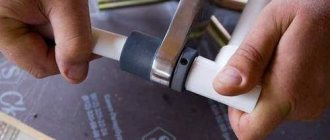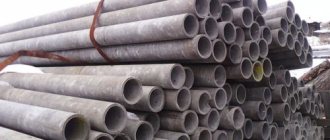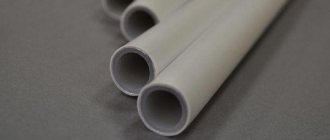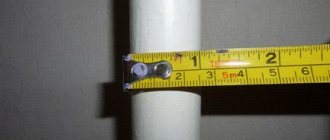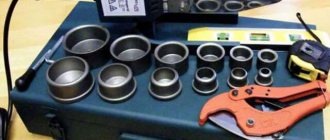Increasingly, plastic pipelines are used to replace old pipes that are part of the household communication system. At the same time, apartment owners are trying to install this system with their own hands. One piece of pipe is not enough to complete the job, but you have to cut a lot of plastic pipes and without the availability of equipment - this will not be easy to do. Therefore, an indispensable tool in this process is scissors, which can easily cut plastic material. For laying new communications, fasteners for installing plastic pipes are also used. This article provides information about the types of tools for cutting plastic pipes, as well as describes their features and methods of use and tells a little about fasteners.
Types of scissors for cutting polypropylene pipes
Modifications of pipe cutters
They are completely different and have their own set of technical characteristics.
- precision scissors;
- roller hand pipe cutter;
- scissors with ratchet mechanism;
- battery shears for polypropylene pipes;
- guillotine.
Precision shears for polypropylene pipes
They have a simple design that allows you to work using one hand. Their main task is cutting pipes and PPR. With a diameter of 2 – 41 mm. The tool has a blade made of alloy steel. These scissors are suitable for small-volume work.
Roller plastic pipe shears
They are equipped with an arc-shaped body with a handle, and the blade is flat and rounded with rollers. It is the rollers that cause the pipe to rotate, and the blade cuts it. The model has a low price, which makes it quite popular. The scissors are easy to use and make it possible to cut material at a ninety-degree angle.
Cordless shears for polypropylene pipes
They stand out for their significant speed in cutting pipes. This tool is often used by workers who install drainage systems. The scissors have an electric motor, which makes it possible to cut polypropylene with high quality, achieving a clean cut.
Guillotine scissors
Convenient to work with pipes that have a large diameter - 63 - 360 mm. The blade is coated with Teflon, which ensures a perfectly even and smooth cut.
Prices for quality shears for polypropylene pipes vary depending on the diameter of the pipes that the tool can handle. Models for pipes with a maximum diameter of 42 mm are sold at a lower price, and for example for pipes 75 mm at a much higher price.
The most popular models of good scissors for polypropylene pipes
In specialized stores, you will find a wide variety of models, with different characteristics and prices. Before you go shopping, read the instructions for the models you are interested in and reviews about them, this will make your task much easier.
The PPC42 FIRAT model is used for installation of equipment for indoor climate control, as well as sewage systems. The tool is suitable for cutting pipes with a diameter of 2 – 4 cm with a perfectly even cut.
Valtec polypropylene pipe shears - guillotine, are used for cutting polypropylene pipes with a small diameter of 3 cm. The toolkit has a ratcheting mechanism that ensures high-quality cutting of plastic. When working with this model, there is no need to disconnect the support and disconnect the support rail, since the design has a spring that rotates the structural parts to the initial position.
Inforce polypropylene pipe cutters with a ratcheting mechanism attract attention due to the ratio of reasonable price and excellent quality. Suitable for pipes with a diameter of up to 42 mm
It comes with a razor-sharp blade that ensures a perfect and smooth cut. It has one drawback - a metal handle without rubber pads. Therefore, we recommend using gloves for convenience while working.
Rothenberger polypropylene pipe shears have high build quality and a convenient design. The tool is suitable for working with pipes with a diameter of 0.5 - 4 cm. The blade is durable, thin and very sharp. The handle has a convenient lock that prevents the tool from slipping out of your hands, as well as rubber inserts.
I-TECH - telescopic shears for polypropylene pipes with a diameter of 6 cm, from a Chinese manufacturer; there are also models for thin plastic pipes. The tool is inexpensive, has good design characteristics, and a thin steel blade.
Scissors for cutting polypropylene pipes KRAFTOOL are from a German manufacturer, but are produced in Chinese factories under the name EXPERT. Suitable for pipes with a diameter of 42 mm. Blade made of high quality steel. The body is made of duralumin, so the tool is lightweight and fits comfortably in the hand.
MILWAUKEE C12 PPC-0 cordless pipe cutters, made in the USA. They have an automated system that allows you to make 200 pipe cuts in one full charge.
Milwaukee Electric Tool - made in the USA. A tool that has proven itself to be excellent for cutting pipes with a diameter of 12 mm to 5 cm. Charged from a 12 V battery.
General operating principle of the tool
The specific mechanics of the operation depend on the type of scissors. Classic models involve impacting plastic material with cutting metal parts. Moreover, the design is carried out in such a way that a minimum of pressing effort is required from the user himself. In addition, scissors for cutting plastic pipes, depending on the design, can be adjusted to the technical characteristics of the workpiece. The simplest devices are intended for products with a certain diameter or, at best, can serve pipes of different sizes, but with a narrow range.
Types of scissors for cutting polypropylene pipes
PP pipes are sold in the form of straight sections up to 12 meters, as well as in coils. Naturally, in the process of laying pipes, quite often there is a need for cutting and welding.
Even though the polymer structure is quite soft, it is not easy to damage. Cutting polypropylene pipes can be called a difficult process, especially considering that the cut must be extremely smooth. Otherwise, at the stage of joining the pipes, you will need to spend a lot of unforeseen time on aligning the joints. Since the pipeline is laid end-to-end, any, even the most minimal deviation will cause a poor result. Poor tightness, which is no secret to anyone, will cause a pipeline break.
When buying scissors for polypropylene pipes, every person wants to choose both a high-quality and inexpensive product. In this case, it is worth understanding that if you are planning a simple repair, during which you will lay only a few segments of the pipeline, scissors will be enough at a minimal price. They will be equipped with a blade made of cheap steel grades, so in comparison with more expensive analogues, their quality will be significantly lower, and accordingly they will become dull faster. But is it worth overpaying if you are going to use the tool for cutting polypropylene pipes several times?
If you plan to install plastic pipes very often, then in this case you simply cannot do without a high-quality tool (for more details: “What tools are needed for polypropylene pipes and how to use them during installation”).
On sale you can find several types of scissors for propylene pipes.
There are precision shears for polymer pipes that are equipped with a ratchet. They have a simple design and are easy to use. Along with sufficient reliability, their price is at an average level and, as a rule, does not exceed $20. Additionally, the price may be influenced by what sections a specific product model allows you to work with. Typically, for sections up to 42 mm, scissors will be cheaper. But if you plan to cut 63-75 mm pipes, you will have to pay a lot for such a model.
You can purchase automatic scissors that are shaped like a pistol. We can say that they are somewhat similar to the previous version. And even despite the fact that this kind of knife for plastic pipes is much more expensive, they are often bought by home craftsmen, since such a tool allows you to cut pipes of any cross-section. Automatic shears are ideal in places where pipes are located close to the wall. When cutting a pipe in a hard-to-reach place with this tool, you will need to use less force with the brush.
Roller type pipe cutters. They are also easy to use. In inexpensive models, the movement of the knife for cutting plastic pipes is carried out by a threaded drive. The pipe is fed along rollers placed on a C-shaped arc, which in turn is installed opposite the blade. More expensive models have a ratchet-type mechanism.
Electric pipe cutter. From the name it follows that the tool is equipped with an electric drive - it has an advanced design of manual elements for cutting pipes. The only difference is that in this case the scissors do not work from the force applied by the operator’s muscles, but from an electric motor. In order for the knife for cutting polypropylene pipes to do its job, you need to fix the pipe in the mechanism of the unit and press the “Start” button. Now we wait until the blades cut the pipe - the result is an even cut. You don't need to put in a lot of effort.
The disadvantage of an electric pipe cutter is that the device is not capable of handling pipes with a cross-section of more than 42 mm, because the existing fasteners do not allow this due to their size.
Types of cutter designs
The standard version includes a ratchet mechanism. In one part there is the cutting part itself, and in the opposite part there is a special round recess for seating the workpiece. How do scissors work to cut this type of plastic pipe? The operation is performed by bringing two handles together until complete cutting is achieved. A slightly different principle of operation is incorporated into telescopic models. Their device includes a staple-like body and a cutting roller, which, when passed along the surface, carries out point cutting.
Instructions for use
How to use hand scissors:
Measure the pipe sections and make appropriate marks. Place the pipe section in the tool, positioning it so that the blade is located above the mark. You can first make a small incision yourself. Using a smooth but strong movement, press the handle of the pipe cutter
The pipe must be placed exactly perpendicular; it is important to ensure that there is no accidental change of location. After cutting, the ends of the pipe are processed, if necessary.
Thus, choosing a tool for cutting pipes requires time and preparation and must be light in weight. First of all, you need to know the diameter and length of the pipeline.
To determine the manufacturer, use the rating of well-known companies; their products will function efficiently. Also, before starting the procedure, it is recommended to familiarize yourself with the video lesson on how to cut a pipe evenly.
Watch the video
Conclusions and useful video on the topic
Some tips on choosing scissors are in the following video:
Pipe cutters for polymer pipes are useful and popular tools designed to greatly facilitate plumbing installation work. Thanks to the variety of designs and models, it has become possible to process pipes of different diameters and any wall thickness.
Cutters and scissors easily cut not only ordinary pipes, but also metal-plastic products. The need for such a tool cannot be overestimated.
How to choose pipe cutting shears
For home use or occasional use, mechanical pipe shears are usually the way to go. The design is chosen to be “cheap and reliable.” Most often, scissors with a ratchet are purchased. In principle, a justified choice. Beginning professionals also work with them. You just need to choose the right model.
Important components of pipe shears
In general, the following recommendations can be given for choosing the type of pipe cutters. A thin-walled pipe without reinforcement made of any material can be cut with a pipe cutter or scissors of normal quality, regardless of the design. Restrictions on diameter - 32 mm, on wall thickness - up to 4-5 mm. Any pipes, what are they? Yes, everything: metal-plastic (MP), polyethylene (PERT, PEX), polyvinyl chloride (PVC), PVDF, low-density polyethylene (HDPE), polypropylene (PP, PPR or PPR), including fiberglass reinforced pipes and even small pipes (diameter 16 -20 mm), reinforced with aluminum foil. For the same pipes, but with a diameter of 4 mm or more, more powerful scissors are needed. They should be larger in size and “tougher” in assembly.
Which scissors are best for PVC, PPR, PET, MP pipes
For reinforced polypropylene and PEX with a diameter of 25-40 mm, a good roller cutter is required, and for even larger ones you need a guillotine or the same roller shears, but from the professional series.
Technical specifications
There are no difficulties at this point. There are two things to keep track of:
- the maximum diameter of pipes that the shears can cut;
- what kind of pipes they can cut.
Look carefully at these characteristics. It can be a shame: you buy scissors for polypropylene pipes for a couple of thousand, and then it turns out that they don’t cut polypropylene.
First of all, we look at whether the type of material we need cuts, then we pay attention to the diameters
By the way, with a cheap tool, the pipe with the stated largest diameter sometimes simply does not fit into the holder. So you need to check. If you don’t have a piece with you, compare the dimensions of the cutting part with similar ones. Are the sizes more or less the same? Great. If the ones you have chosen look smaller, it is better to set them aside.
Frame
The scissors body can be made of silumin or other similar alloy and steel. Inexpensive silumin models can break if you press hard when cutting a large diameter pipe. So if we take silumin ones, then those that look solid and weigh not a hundred grams. We inspect the body for cracks, cavities, burrs - there is such damage. We immediately put them aside. Next, we look at the following features:
- You need a strong, powerful body.
- No backlash. If the new scissors dangle, the cut will not be smooth. And if you also work with them, you will have to hold everything with your hands.
- The wide lower part where the pipe is laid. To obtain an even cut, it must be held firmly. If there is only a thin strip at the bottom, this is not easy to do. So make sure that the lower “lip” is large.
We examine the handles. The main thing is that they are comfortable. We will have to squeeze them, so we also put aside the sharp edges that lie awkwardly in the hand. The best option is rubberized or with rubber pads. But this is already a low-budget series.
What kind of blade could it be?
The main working part of pipe cutting scissors is the blade. It can be made of tool (cheaper and softer type of steel) and alloy (more expensive and durable) steel. Generally, an alloy steel blade can cut plastic and copper pipes. Scissors for polypropylene pipes have a blade made of tool steel.
The type of steel is not everything. You need to look at the thickness of the blade. If it is thin, with a large diameter the cut goes to the side and cuts the pipe at an angle. But we need it at 90°.
Gun Pipe Cutter Mechanism
The thicker the blade, the easier it is to work. By the way, there are models of scissors for polypropylene pipes with a removable blade, and there are those in which the blade and the “ladder” of the ratcheting mechanism are one whole. The second option is more durable. The fewer connections, the longer the service life.
What types of products are there?
To avoid mistakes when choosing, you need to understand the classification of products. All products produced by manufacturers differ not only in characteristics and functionality, but also in design features and operating principles. Various construction tools are used for cutting propylene, metal-plastic and PVC. What to look for when choosing a product? Dividing popular models by type. On sale are:
| Type | Description |
| Roller | According to buyers, the simplest devices. The appearance resembles a hook. Equipped with movable rollers on the inside. When cutting a plastic workpiece, it is gradually rotated along the rollers, which leads to a cut. In the process of performing manipulations, it is necessary to apply some effort with both hands. The cutter is of a replaceable type and is a consumable item that must be changed periodically. |
| Precision | Simple design. One hand is enough for operation. Easily and simply copes with plastic pipes whose diameter ranges from 2.5 to 42 mm. You can purchase special devices for working with 70 mm polymer structures. The knife is made of alloy steel. When choosing, you should pay attention to the following nuances: • the sharpness of the blade and the possibility of replacing it; • ease of use (the product should not rub your palm). The device is quite durable and guarantees a perfect cut. Devices with a ratcheting mechanism are considered the best for use in domestic conditions during construction or repair work. |
| With ratchet mechanism | A more advanced model of the roller analogue, but it costs more. Convenient to use. You don't have to put in a lot of effort. Simplicity and precision of cutting is achieved using a stop and cutting rail. How does the device work? It has a wide support to securely support your knee. This helps keep the fixture perpendicular and level. The stop allows you to minimize the possibility of changing the position of the device, so the cut is smooth. The scissor blade is so sharp that it glides gently across the surface of the workpiece. |
| Guillotine | Convenient and reliable design for cutting pipelines. Allows you to apply a minimum of effort to achieve a positive result. An even cut is guaranteed in a short time. Used when laying networks of considerable length. They work with workpieces with a diameter of 60 - 360 mm. |
| Rechargeable | An analogue of a hand-held device, only improved. Frees the craftsman from exhausting work. All elements are battery powered. The presence of an electric motor allows you to quickly make a cut. Belong to the category of professional equipment. It can often be found when laying large-scale heating and water supply lines. How do the devices work? The area of the pipe that needs to be cut is inserted into a special clamp. The engine is activated. It is done. How much does the tool cost? Quite expensive, so it is not suitable for occasional use at home. It will never pay for itself. |
Rules for using the device
It is worth noting that there is nothing complicated in using cutters. Just a little practice and things will get better. The main task is to choose the right device. To make cuts from 16 to 20 mm, it is possible to use any type of scissors, including budget spring ones, made in the Middle Kingdom. If the diameter of the workpiece is maximum, then you should give preference to professional designs and durable modifications from time-tested manufacturers.
Before starting work, it is advisable for beginners to read the instructions for using a particular product. When operating, experts recommend following this order:
- A mark is made on the outer shell of the workpiece.
- The part with the mark is placed on the edge of the half of the pad, and 15 mm is added for soldering. This small segment will be inside another element.
- The knife is installed on the outside of the workpiece. The entire surface of the pipe is pressed against a semicircular platform. Distortions should be avoided.
- Pruning is carried out carefully, without applying significant effort. To do this, just press the handle of the device.
- The cut is checked. If the walls are slightly wrinkled, they are leveled using a calibrator.
- The work is done.
- To make a new cut, the scissors must be opened by stretching the handles and different sides. There are models with a special button on the body, which, when pressed, opens the device.
Experts advise avoiding sudden movements when working. Otherwise, the cut may be unsatisfactory. You will have to spend a lot of time cleaning and leveling.
Shearing problems can occur if the blade length is incorrectly selected for a specific pipe diameter. A cutting blade that is too short cannot lead to a positive result. There is no need to try to cut a thick pipe with a device that is designed to work with small workpieces.
What tool can be used to cut plastic pipes
Considering that the people in our country are artisans, then they manage to use the most unimaginable means at hand to cut pipes. But you should not think that such cutting contributes to the good quality of the future pipeline. Therefore, we will consider the tools that allow you to cut plastic pipes with the highest quality:
- hacksaw for metal;
- self-sharpening knife (with fine teeth);
- scissors for cutting plastic pipes;
- roller type pipe cutter;
- battery pipe cutter;
- guillotine pipe cutter.
Cutting pipes with a hacksaw or a knife should not be considered seriously, since their use leads to the end of the pipe being frayed and burrs forming, which must be eliminated using sandpaper or stripping with a knife.
In any case, the quality of the cut suffers. These methods can be used for single cuts. If the pipeline has a complex configuration and many connections of individual sections, then it is better not to use these tools. Pipe shears are mainly used for cutting plastic pipes.
- a clearly visible mark is placed on the surface of the pipe, marking the place of the cut;
- the base is placed on top of this mark, controlling its position through the slot in the base;
- then, applying force, they cut into the pipe and, gradually increasing the force, make the final cut of the pipe.
It is clear that with a large number of cuts, the hand quickly gets tired, so the speed of work is reduced. In addition, scissors cannot cut large diameter pipes. The maximum diameter of processed pipes is 42 mm.
In terms of efficiency, a pipe cutter is no worse than scissors. But, unlike them, there is practically no physical effort when working here. The cutting process itself occurs as follows:
- Place a mark at the cut site with a marker;
- the screw is unscrewed from the clamp, and the bracket is brought to the cutting site;
- then the screw is smoothly tightened (so that the pipe does not burst);
- After creating the required force on the cutting roller, the clamp begins to rotate around the pipe, smoothly tightening the tension screw.
Thus, a circular cut of the pipe is made, while the end of the pipe is very smooth, without burrs. The only danger when working with a pipe cutter is the appearance of cracks in the pipe due to too much pressure from the screw.
The guillotine pipe cutter is used to work with pipes with a diameter of 63 to 350 mm. At the same time, the likelihood of deformation or destruction of the pipe walls is reduced to almost zero. The cutting process is as follows:
- Mark the place of the cut on the pipe and insert it into the guillotine, securing it in a sector from 30 to 60 degrees;
- the guillotine blade, which is mounted on wheels, swings around it;
- After the first cut of the plastic, the blade is immersed in the pipe using a rotating screw handle and, thus, the pipe is finally cut.
In this case, the cut is very smooth, without burrs. Guillotine blades are easily replaced. Modern guillotines have blades additionally coated with Teflon.
Versions of tools for working with metal-plastic
For such tasks, you should prepare a special version of scissors. These are precision-type models, characterized by the presence of a ratchet mechanism. But even among them, not every model can cut metal-plastic. As a rule, large modifications designed to service large diameter pipes are suitable. The wide cutting area provides additional gripping benefits, so it can handle hard material. There are also automatic scissors for cutting plastic pipes, which can be used to perform similar activities, but they are less commonly used in the household segment. As a rule, if you need to cut the same metal-plastic, a power electric tool like an angle grinder is used.
Types of scissors
There are the following types of presented tools, which can be:
- precision;
- roller;
- battery (automatic).
Precision shears for cutting polypropylene pipes are equipped with a special ratchet mechanism and blades that are equipped with a toothed plate.
They are used for dividing pipes with diameters of 3-42 mm into sections. This product is very convenient and quite easy to handle.
Cutting is done without the application of strong physical effort. The disadvantage is that when performing work, the blade often moves to the side and the edge of the cut is not always quite even.
The roller pipe cutter can be telescopic or with a ratcheting mechanism. Trimming polypropylene pipes is carried out by rolling rollers over them.
The advantage of this tool is that it forms perfectly smooth cut edges, but the disadvantage is the relatively low speed of work.
Scissors for cutting polypropylene pipes
In telescopic modifications of the device, the cutting edge can rotate around the pipe, which ensures cutting.
Automatic (battery) shears are equipped with a compact electric motor.
This ensures the shortest possible cutting time - only 5-7 seconds. As you might guess, the main advantage of such a tool lies in the high speed of work performed.
But the disadvantage lies in the fact that such a pipe cutter can be used for cutting pipes with a maximum diameter not exceeding 40 mm.
Tips for choosing
When choosing such a tool, it is important to ensure that the price offered is fully consistent with the quality. If the product will be periodically used for minor repairs, then it would be most rational to buy scissors with an insufficiently high price
If the product will be periodically used for minor repairs, then it would be most rational to buy scissors with an insufficiently high price.
But it should also be taken into account that the cheapest analogues are characterized by a reduced quality of the materials used to make the blades.
When choosing automatic shears, you can be sure that they will allow you to cut those pipes that have a large diameter.
Precision scissors are distinguished by their versatility coupled with an affordable price. This product has a high degree of reliability and very high ease of use.
The price may fluctuate depending on the diameter of the pipes that need to be cut. Most work tools rely on the operator's muscular strength, and chronic fatigue can occur with large amounts of work.
In case of serial work, it is recommended to use a cordless pipe cutter, while a guillotine cutter is suitable for pipes with large diameters.
Nuances of the work
For convenience, the blade of the tool is equipped with a special rack with fine teeth on it.
This allows you to apply a minimum amount of effort when carrying out work. The scissors are designed in such a way that they can be held with only one hand, and the other will be free to perform other actions.
When installing a pipeline manually, out of habit, you can quickly get tired - electric scissors for cutting metal-plastic pipes will come to the rescue.
When choosing a tool, it is best to give preference to well-known manufacturers - lower-cost Chinese analogues can fail quite quickly.
This is how a polypropylene pipe is cut
If a section of the pipe was damaged during the trimming process, it should be removed, otherwise the connection with the fitting will not have the required tightness. Slicing is performed based on the following algorithm:
- The surface of the pipe is marked with a marker in the place where trimming will subsequently be performed.
- The base blade is placed on top of the mark. In order to more conveniently fix the tool, you can initially make a shallow slot in the material.
- Without putting too much pressure on the handles, it is necessary to carefully cut into the pipe and trim, making efforts to do this.
- When performing work, you should avoid sudden movements with your brush, otherwise the scissors may accidentally slip off the guide rail and the whole process will have to start again.
- The base blade must be positioned precisely along the surface of the pipe.
Thus, using this tool and following the instructions, you can easily cut the desired section of the metal-plastic pipe.
Preparing for work events
To get a high-quality result, both the scissors and the pipe should be prepared accordingly. As for the tool, before work, its functionality, reliability of design and accuracy in guiding the cutting part are checked. To check, it is advisable to perform several test operations on waste material. This will allow you to assess how ready the mechanism is to create smooth edges. How to open scissors for cutting plastic pipes? This is done using two handles. The test procedure should be carried out with maximum wiring in order to fully check the quality of the mechanism. In this case, the flow pipe must correspond to the diameter of the workpiece. The target material, in turn, is cleaned and lubricated with degreasing compounds before working operations. Performing this procedure will eliminate the risk of the cutting part slipping and improve grip.
Choosing a pipe cutter – mechanical vs electric
In everyday life, for one-time work, it is recommended to use hand-held cutting tools. It costs less than an electric one and is easier to use.
If you need to make several cuts to install a water supply in a private house or apartment in the area from the riser to some plumbing, then this is simply the ideal choice. However, with large volumes of work, cutting pipes with it will take a lot of effort and time.
Manual pipe cutters are powered solely by the muscular strength of the installer - if you plan to independently install long pipelines in a cottage, then it’s worth purchasing a power tool
Electrical equipment will cost more than its mechanical counterpart. But it greatly facilitates and speeds up the process of cutting polypropylene pipes. The result is smoother edges. In this case, you do not have to exert force to press the handle; you just need to hold the electric pipe cutter exactly along the cutting line. Errors are practically eliminated.
Every power tool requires power to operate. If there are problems with this (electricity has not yet been connected to the newly built house or accidents constantly occur), then it is better to prefer a manual pipe cutter. You will have to work hard and put in effort, but the installation of water supply and sewerage will be completed on time without delays.
The manual pipe cutter has compact dimensions. It is often simply impossible to bring a bulky electrical analogue to an already installed pipeline in order to make a tie-in into it. But with hand scissors you can make such a cut without any problems.
An alternative to both of these pipe cutter options is an electric one with a removable battery. Such a tool weighs only 1.5–2 kg. The electric drive makes the cutting process easier, but you don’t have to look for an outlet to connect such “scissors.” The battery usually lasts for a couple of hundred cuts, which is quite enough for a full day of work.
Pipe cutters wholesale from the manufacturer
carries out wholesale and retail trade, and is also a manufacturer of pipe cutting scissors (pipe cutters), supplied to private plumbing stores and large DIY stores. We provide a detailed price list for the entire range, have ample options for payment and delivery, and also provide advice on any issue. Over the years, we have established partnerships with many stores and suppliers.
Our specialists will help you organize your own business and select the necessary products.
Still have questions? Call or write - we will answer. Phone: +7 E-mail Address: St. Petersburg, st. Zastavskaya, 5/1.
Tool manufacturers
This tool is produced by manufacturers of construction machinery and equipment. In particular, Jonnesway offers versions for processing pipes with small diameters up to 28. The Kraftool range includes modification 23381-42, which allows cutting workpieces with a thickness of 42 mm. For universal household use, it is worth purchasing scissors for cutting plastic pipes Elitech 2110 001100, which have a coverage of 16-42 mm. If we are talking about production communications, then the Gerat 63358 device may be required, thanks to which lines with a diameter of up to 300 mm are serviced. Domestic manufacturers also offer high-quality scissors for such purposes. For example, for 35 mm blanks it released a durable and functional modification 9631. As for the cost, in the entry-level segment it is easy to find options with price tags of up to 500 rubles. Even large manufacturers contain budget models in their lines for 200-300 rubles. Of course, as the diameter increases and the operating range expands, the cost also increases. Professional scissors are available, on average, for 1.5-2 thousand rubles.
Products from leading brands
This segment of the modern market offers products from many manufacturers. However, the most popular are the products of the following foreign companies: Rothenberger, Reed and General. Information about the scissors they produce for cutting metal-plastic, polypropylene and PVC pipes is presented in the summary table below.
Table 1
| Model/brand | Diameter of cut pipe, mm | Weight, kg | Pipe material |
| Rothenberger ROCUT TC 75 | 0-75 | 1,5 | Polypropylene |
| Rothenberger ROCUT TC 63 | 0-63 | 1,3 | Plastic PP |
| Rothenberger ROCUT 63 | 0-63 | 1,26 | PP |
| Rothenberger ROCUT TC 50 | 6-50 | 0,6 | Plastic PP |
| Rothenberger ROCUT TC 42 | 6-42 | 0,447 | PP |
| Rothenberger ROCUT 42 | 0-42 | 0,42 | Polypropylene |
| Rothenberger ROCUT S 35 | 6-35 | 0,74 | Polypropylene |
| Rothenberger ROCUT TC 32 | 6-32 | 0,22 | Plastic PE |
| Rothenberger ROCUT 32 | 0-32 | 0,32 | PP |
| Rothenberger ROCUT S 26/42 | 6-42 | 0,85 | Polypropylene |
| Rothenberger ROCUT TC 26 | 6-26 | 0,37 | Polypropylene |
| Reed SC1 | 32 | 0,1 | Thin-walled plastic |
| Reed RSP1 | 42 | 0,4 | Polypropylene, PVC |
| Reed RS7290 | 63 | 1,1 | Plastic PE |
| Reed RS2 | 63 | 1,3 | PP |
| Reed RS1 PLT | 42 | 0,4 | PVC plastic |
| Reed RS1 | 42 | 0,4 | Polypropylene |
| General SUSH | 0,5 | Plastic (metal-plastic) |
After cutting, the cross-section of plastic pipes changes. A calibrator is used to restore it. It not only returns the cut to a round shape, but also removes the internal chamfer. This tool is inserted into the pipe and rotated several times.
Good to know! The knife included in the design of the calibrator will completely clear the bevel from the pipe only if the cut is made strictly perpendicular to the longitudinal axis of the pipe and the calibrator itself is not skewed.
How to cut metal-plastic pipes
Metal-plastic pipes have a number of advantages over their competitors. They are much lighter than metal and much more resistant to oxidation than copper. They are easy to replace and easy to shape into the desired shape.
You can create a pipeline of any shape. Well, the main advantage is the cost. It is much lower than that of copper pipes. And the quality is approximately at the same level.
During operation, it may be necessary to cut pipes. For this, a special tool is used that is designed to work with such material.
To increase the effectiveness of the procedure, it is recommended to properly prepare the pipe and tools before work. Let's look at the main features of metal-plastic pipes and how to cut them.
Preparing the pipe and necessary tools
The tools used are the cutting device itself, measuring tapes, adjustable wrenches, seals and some other things. All this must be in an accessible place at the time of work.
Sometimes it is necessary to scrape the outside of the reinforced coating to make the cutting process easier in the next step. For stripping, a coupling with blades is used, which allows you to get a perfectly even cut and get rid of the polymer layer. This is necessary for welding work, which will most likely be carried out during pipeline installation.
Important! When working, it is necessary to cut off exactly as much material as is needed to attach the fitting for metal-plastic products.
Tips for choosing
Before choosing and purchasing such a device, you need to ensure that the quality fully corresponds to the offered price.
If you plan to use the device for minor plumbing repairs, then buying expensive scissors is not advisable. However, do not forget that the cheapest scissor options are of very low quality. Often their blades are not coated with a special substance, and they are not sharp enough.
If you have chosen an automatic device, then you need to make sure that the scissors can easily handle large-diameter pipes.
So-called precision scissors have always been famous for their versatility and low price. Such devices have always been reliable and quite convenient to use.
Installation
The installation of internal sewerage and external mains is in many ways similar. The difference is in the materials used. For internal sewer systems, gray-painted collectors are used. The outer ones have an orange tint. This is due to the difference in external loads:
- Products located indoors are subject to their own weight and, periodically, the load from flowing liquid. Thermal heating is added to 60–90°C with a parallel chemical attack from the components of the effluent.
- Parts located outside the building are subject to:
- pressure from the mass of the covering soil;
- exposure to the weight of passing vehicles;
- experience forces from buildings located above;
- exposed to external temperature changes, from negative to positive.
Hence, the installation of internal sewerage is carried out with a predominance of polymer materials:
- PVC (polyvinyl chloride). More precisely, unplasticized PVC (PVC-U).
- HDPE (low density polyethylene).
- PPR (polypropylene).
The most in demand are PVC products. Installation of internal collectors is carried out by joining the narrowed part of the pipe and the expanded part (socket). Additional elements are used - fittings (reducing couplings, tees, elbows with an angle of 45° and 90°, bends).
Installation of sewer pipes is carried out with obligatory observance of the angles of inclination:
- For a Ø 50mm collector, the slope will be 2–3 cm per linear meter of length.
- For a product Ø 100mm, about 1–2 cm per 1 meter.
During installation or repair work, there is a need to cut a plastic part. Polymers do not have high hardness and strength compared to metal products. Therefore, they can be processed with most metalworking and mechanical tools. It is possible to cut a plastic pipe using:
- hacksaws for metal or with fine hardened teeth;
- triangular file;
- jigsaw (for diameters not exceeding 50mm);
- circular or reciprocating saw;
- grinder and other tools.
Installation of sewerage systems is carried out according to the rules based on the requirements of SP 30.13330.2012. In addition to observing the slopes, it is necessary to correctly distribute the points of attachment and connection. If technically possible, it is recommended to carry out hidden wiring.
Installation of sewer pipes indoors begins:
- from drawing up a work plan;
- execution of a sketch or drawing;
- determining the required dimensions of the collector;
- procurement of the necessary material;
- preparing a tool with which you can cut a plastic part.
At the end of the installation stage, the internal sewage system is checked visually. Next, it is necessary to flush the system with water in order to identify possible product defects or leaks.
Cutting technology
First of all, you should correctly mark the cutting line. The segment is marked strictly according to the required size of the part being replaced. If we are talking about telescopic models, then the workpiece is clamped in the appropriate niche, after which it is fixed with a screw. Next, the user scrolls the roller along the cutting line and the operation is completed. How to use scissors to cut standard type plastic pipes? Also, the workpiece is placed in the cutting area, and then cutting is performed by bringing the handles together. It is important to emphasize that the pressure itself should not be applied sharply, but smoothly. Otherwise, there will be a risk of not only getting uneven edges, but also a deformed pipe even beyond the cutting point. After the operation, if necessary, you can refine the end of the workpiece with fine-grained abrasives. Sometimes, as an additional operation, plumbers also perform thread formation with another specialized tool. Although for plastic products this operation is less relevant.

